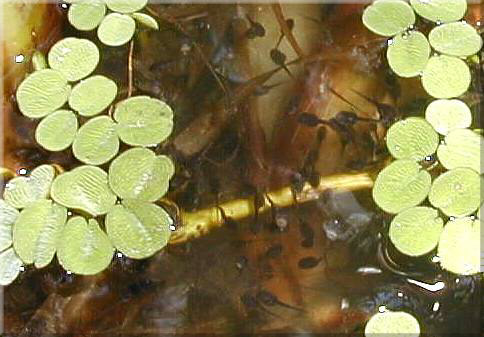The Frogs of St. John
Cuban Tree Frog
(Osteopilus septentrionalis)The Cuban tree frog was first introduced to St. Croix in 1974 at the West Indies Laboratory (probably an escaped experiment!). It arrived in St. Thomas in 1975 (probably as a stowaway in horticultural products from St. Croix). Its first appearance on St. John is not known...but we know it's here! It's mature body ranges from 3 to 5 inches with some undocumented reports of up to 10 inches in length. It is notable by its exaggerated toe pads which are partially webbed on the hind foot. Body markings range from solid beiges and browns, but are sometimes mottled with brownish or black spots. It's skin mucous is toxic to humans, especially to skin, eyes and mucous membrane...swelling, redness and itching are primary symptoms...avoid touching or having them leap on you. Wash affected area with soap and water quickly if contact is made. These effects are short term only (hours).

Mating pair of Cuban frogs
Cuban Tree Frog

The male tree frogs sing to attract females. They only sing during wet times when conditions are good for eggs. Few will sing when it is dry; but they will sing in large numbers after a rain. The males create their song by moving air back and forth between their lungs and an air sac below their mouth. They are difficult to find, for they are less than an inch long and tan; blending in well with most foliage. The timing of their calls is distinct and planned. When a frog begins singing, he will identify a period when no other frog is singing and take over that time slot, resulting in a group of frogs who sing in the same sequence for quite some time.

Antillean Fro
Eleutherodactylus antillensisEleutherodactylus antillensis averages about 30 mm. The color of the Antillean Frog can range from a pale gray to dull brown or even slightly violet-red. Features that distinguish this frog from others in the genus are their black-spotted, marbled thighs and their cinnamon-colored eyes. The Antillean Frog has a very angular head with a black streak margining the snout on both sides. Toe pads are small.
Eleutherodactylus antillensis can be found in forest/wooded areas. During the day, these frogs are ground dwellers that hide under grass roots, loose bark, rocks, logs, or trash. This species feeds primarily on insects.
Vocalization: Their call has been described as sounding like "churee-churee". The call is continuous but occasionally different calls enter the series—such as a "ki-ki-ki-ki….". Males call from low bushes and branches from dusk til dawn.
Nesting/breeding on St. John, Puerto Rico and all Puerto Rican islands except Mona and Monito, St. Thomas and its adjacent islands, all British Virgin Islands except Anegada, and St. Croix and its adjacent islands.

Puerto Rican Whistling Eleuth
Eleutherodactylus cochranaePuerto Rican whistling eleuth, Eleutherodactylus cochranae, male.
Like the red-eyed eleuth, it is found in the northern Virgin Islands, as well. Its voice is a long, piercing whistle, often followed by a couple of clicks.

